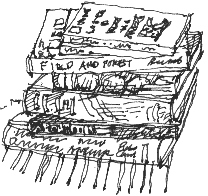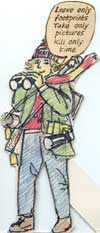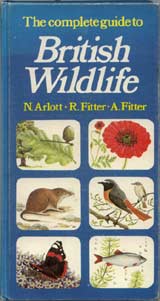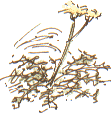
 'My
walking mates and I have had an idea for you.' says John, who lives at the
end of the road, 'We walk all over the countryside but we don't know what
we're looking at; we know the basic trees but then there are other's that we
haven't got a clue what they are.
'My
walking mates and I have had an idea for you.' says John, who lives at the
end of the road, 'We walk all over the countryside but we don't know what
we're looking at; we know the basic trees but then there are other's that we
haven't got a clue what they are.
'We need a book with the things you're likely to see, just a simple guide
to all kinds of wildlife with, for example, silhouettes of the tree in summer
and winter and a leaf.'
 'It's a good idea,' I say, 'but it's going to take some carrying; it would
be enormous!'
'It's a good idea,' I say, 'but it's going to take some carrying; it would
be enormous!'
'No, it would have to be a small book; just including the things you're likely to
see.'

 'Yes,
but you'd see different things depending on where you were.' I tell him, 'You'd
see different things on the coast or in the hills. Besides, with any guide
that
includes
a selection of
species,
you can guarantee that the one you're trying to identify will be the one that
isn't in.
'Yes,
but you'd see different things depending on where you were.' I tell him, 'You'd
see different things on the coast or in the hills. Besides, with any guide
that
includes
a selection of
species,
you can guarantee that the one you're trying to identify will be the one that
isn't in.
'I was looking at lovely photographic guide to wild flowers at Armitage's',
reduced from £25 to £4.99 but it said that out of a possible 3,000 species
they'd chosen a 'representative' selection of about 600.
'You'll have seen that flower
that's growing all along the bypass in a bright yellow line along the
verges; it's autumn
dandelion (right),
but I bet you wouldn't find it in their selection.'
In
fact, there is a field guide very like the one John was suggesting that I
should write. When I was working on Richard Bell's Britain in 1979
-80 for Collins, bird illustrator Norman
Arlott was painting over 1,500 flowers, fungi, birds, snakes, seashore
creatures, farm animals and more for The Complete Guide to British Wildlife,
written by R. Fitter and A. Fitter. It is
no longer in print but I notice that copies are still available through Amazon,
where it gets a 5-star rating from readers, but be careful not to purchase
Collins' new photographic field guide with a similar title because you'll miss
out on this tour-de-force
of natural
history illustration.
 It doesn't include Autumn Hawkbit (a.k.a. Autumn Dandelion) Leontodon
autumnalis, but it does include the virtually identical-looking Catsear, Hypochaeris
radicata, and, come to think of it, it's probably Catsear that is growing
along the bypass! Must take a closer look at it.
It doesn't include Autumn Hawkbit (a.k.a. Autumn Dandelion) Leontodon
autumnalis, but it does include the virtually identical-looking Catsear, Hypochaeris
radicata, and, come to think of it, it's probably Catsear that is growing
along the bypass! Must take a closer look at it.
You can't really identify
plants when you're driving past at 40 mph!
Link: Norman Arlott at the Society of Wildlife Artists

 'My
walking mates and I have had an idea for you.' says John, who lives at the
end of the road, 'We walk all over the countryside but we don't know what
we're looking at; we know the basic trees but then there are other's that we
haven't got a clue what they are.
'My
walking mates and I have had an idea for you.' says John, who lives at the
end of the road, 'We walk all over the countryside but we don't know what
we're looking at; we know the basic trees but then there are other's that we
haven't got a clue what they are. 'It's a good idea,' I say, 'but it's going to take some carrying; it would
be enormous!'
'It's a good idea,' I say, 'but it's going to take some carrying; it would
be enormous!'
 'Yes,
but you'd see different things depending on where you were.' I tell him, 'You'd
see different things on the coast or in the hills. Besides, with any guide
that
includes
a selection of
species,
you can guarantee that the one you're trying to identify will be the one that
isn't in.
'Yes,
but you'd see different things depending on where you were.' I tell him, 'You'd
see different things on the coast or in the hills. Besides, with any guide
that
includes
a selection of
species,
you can guarantee that the one you're trying to identify will be the one that
isn't in. It doesn't include Autumn Hawkbit (a.k.a. Autumn Dandelion) Leontodon
autumnalis, but it does include the virtually identical-looking Catsear, Hypochaeris
radicata, and, come to think of it, it's probably Catsear that is growing
along the bypass! Must take a closer look at it.
It doesn't include Autumn Hawkbit (a.k.a. Autumn Dandelion) Leontodon
autumnalis, but it does include the virtually identical-looking Catsear, Hypochaeris
radicata, and, come to think of it, it's probably Catsear that is growing
along the bypass! Must take a closer look at it.